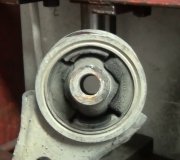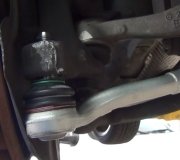That type of wear can only be caused by both wheels leaning to the left on top. That is one of the main alignment angles called "camber". On Ford products if it is wrong, too bad; there's no adjustment. On most Chrysler products it is adjustable. On many GM front-wheel-drive cars like yours, it is either adjustable or it can easily be made adjustable.
The concern here is for camber to be off so much as to cause tire wear on the edges of the tread, you should also notice a horrendous pull to the left when you let go of the steering wheel. Tires want to roll in the direction they are leaning. I cannot say for sure about Saturn's, but on other GM front-wheel-drive cars, the front cross member is lowered with the engine and transmission on it when either of those needs major service. On Chrysler's, when that cross member is reinstalled, the mounting bolts set the position, so it cannot be messed up. There is no such provision on GM's cars. If that cross member is popped back into place with no regard to positioning it the way it was, both front wheels will lean to one side. That changes camber on both wheels along with changing the geometric angles of all the other suspension parts. An inexperienced mechanic might readjust camber, and while those numbers would look good on the alignment computer, it does not address the underlying unequal "steering axis inclination", (SAI). If SAI is not corrected first, you will experience unexpected darting to the side and a loss of "predictability", meaning you never know how the car will react to your steering maneuvers. That makes for a miserable and tiring car to drive. You will be thankful to get out after a half mile of that.
The reason I mentioned all that wondrous information is it is not terribly common on a GM car to have so much camber that you notice the bad tire wear, and it is even less common to have both wheels that badly out of adjustment. It would be much more common to have a shifted cross member. That would be verified by observing the two SAI readings from the alignment computer. There is usually no spec given for SAI. All that is important is it must be the same on both sides, typically within 0.2 degrees. A typical value might be around 28 degrees. To simplify SAI, it is the angle the front strut is leaning in on top, as viewed from in front of the car. All alignment computers measure SAI automatically when taking the initial readings, but we never look at it unless we know it could be involved with the problems we are trying to solve. SAI is one good indicator that a crash-repaired car has been straightened correctly.
I have to assume you are having handling issues along with the tire wear. The place to start is with an inspection at a tire and alignment shop. Your money will be wasted on an alignment if worn steering or suspension parts will not allow the wheels to hold in alignment. In fact, reputable mechanics will not align a car with worn parts until all the repairs have been made. If an alignment is done, ask for a printout to include the "before" and "after" readings. All alignment computers are capable of making printouts. If you post the numbers for "camber', and "toe", front and rear, and SAI for both front wheels, I can interpret them for you.
Monday, July 24th, 2017 AT 8:23 PM


